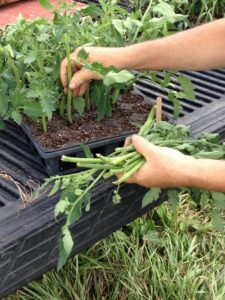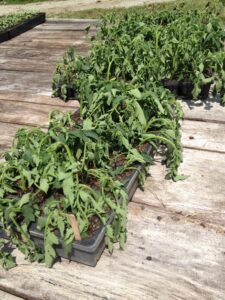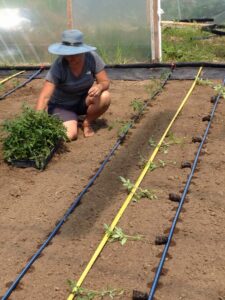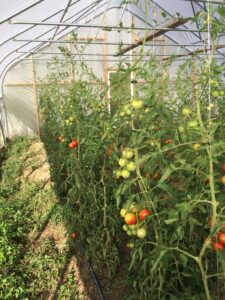2016 Annual Report for FNC16-1025
Economic Implications of Using Tomato Suckers to Produce Late Season Tomato Plants instead of Starting Late Season Plants from Seed
Summary
We finished the first year of our two year project. We purchased and built a 24X48 high tunnel in the spring of 2016. The transplants from seed were started on 05/18/16. The suckers were gathered from the same varieties from field plants and planted in cell trays on 06/24/16 (five weeks later). The soil in the tunnel was prepared and drip tape installed. The seeded and suckered tomato transplants were planted in the tunnel on 07/11/16. The tomato plants were watered, strung, and weeded for the duration of the season. Fruit harvest began on 08/08/16 and continued until a killing frost on 11/11/16. Visual observation, projected timeline was met, and yields records were kept.
Objectives/Performance Targets
The first year we met our objective of setting up the research using the high tunnel to produce late season tomatoes using suckers as plants. We followed the timeline and used the specific methods outlined in the solution in the grant. We believe that affordable, certified organic tomato plants for fall production can be produced using side shoots (suckers) that are pruned from main season tomato plants.
We proposed a trial of organic late season tomatoes produced via transplanted suckers.
This project has two specific sub-goals:
Measure potential yield differences between the plants produced via suckers and late season tomato transplants grown from seed.
Calculate the economic implications of each production system by accounting for any observed yield differences and variations in labor hours.
Specific methods follow:
Tomato plants grown via suckers were the experimental treatment, while tomato plants grown from seed served as controls.
At least 80 tomato plants will be produced in the experimental treatment, with an equal number being produced in the control treatment.
- All tomato plants in both treatments were transplanted into a high tunnel to control for environmental factors, to prevent fungal disease, and to insure that the fall crop is able to produce as long as possible.
Suckers were pruned from main season tomato plants and rooted during late-June. The control plants will be started from seed during mid-May to ensure that both groups of plants are roughly the same size when planted in the high tunnel during early July.
All transplanting and harvest activities did occur on the same day for both control and experimental tomatoes.
Crop yields (weight) and labor hours were tracked for both groups throughout the growing season, and will be assigned a monetary value at the end of the season. This data was used to compare the profitability of organic late season tomato plant production via suckers to traditional plant production via seeds.
Accomplishments/Milestones



We wanted to use varieties that are used in field production in the research since that is what will be available to most farmers using this method of producing transplants. Three varieties were chosen, Fourth of July, Big Beef, and Arkansas Traveler. We found implementing 3 varieties was easy enough to collect data on, and provided additional data on variety selection for the second year and in the future. We found the 2 hybrids performed better than the heirloom variety; we will select a different heirloom for 2017.
We want to note the condition of the suckers when first potted up — they will wilt for a few days before they take root and rebound. This seems normal and still results in a healthy transplant in 2 weeks. The size and maturity comparison of both sucker transplants and the seeded control group were equal at time of planting. This was only an estimate that proved accurate. However, we feel we will start suckers one week earlier in 2017.
The estimated labor hours stand as projected. We are thinking the hours will be less in 2017 because some labor hours were used to build the high tunnel and amend the soil. Now, the system is in place and we should see labor hours decrease.
The only pests we had to monitor for were the tomato horn worm and army worm. We controlled these by hand picking from plants while stringing and harvesting. We believe yield wasn’t affected.
Impacts and Contributions/Outcomes
 The outcome is what we had hoped to see. The suckered tomato transplants used 9 less hours of labor to produce and 5 less weeks of seedling care during our busiest time of the year with less worries. The 9 hours equaled $180 in labor savings. The suckered tomatoes also yielded 26% more fruit overall which equalled $184 in additional income. We are surprised at the increase in yield and attribute this to earlier harvest of fruit by one week or more. We also harvested tomatoes from the high tunnel for 8 additional weeks, extending the season from our field grown tomatoes. All tomatoes were beautiful and disease free from being in the controlled environment of the high tunnel.
The outcome is what we had hoped to see. The suckered tomato transplants used 9 less hours of labor to produce and 5 less weeks of seedling care during our busiest time of the year with less worries. The 9 hours equaled $180 in labor savings. The suckered tomatoes also yielded 26% more fruit overall which equalled $184 in additional income. We are surprised at the increase in yield and attribute this to earlier harvest of fruit by one week or more. We also harvested tomatoes from the high tunnel for 8 additional weeks, extending the season from our field grown tomatoes. All tomatoes were beautiful and disease free from being in the controlled environment of the high tunnel.
We have contacted OEFFA to host a farm tour this summer and also spoke with Tony Nye, our extension agent to see if he had an opportunity for a field day.
We have ordered tomato seeds and supplies needed to complete research for 2017.
We are encouraged and excited to continue, and feel this can help sustainable farmers extend the growing season with less upfront time needed to produce viable transplants.
Collaborators:
That Guys Family Farm
394 State Route 380
Clarksville, Oh 45113
United States
Office Phone: 9372893151